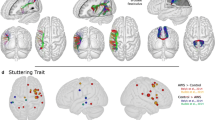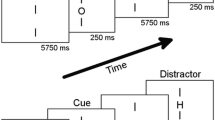Abstract
Emerging neurologic evidence has suggested that developmental and acquired stuttering may have a cerebral base. Investigations have revealed compensatory activation in the right cortical motor areas and deactivation in the left perisylvian region in subjects with persistent developmental stuttering. The evidence has also implicated limbic (cingulate)-basal ganglia regions. Increased speech fluency with treatment in such subjects eliminated compensatory brain activity and shifted activation back to the left hemisphere. We assess the neurology of stuttering and then present our own observations of deep brain stimulation of the thalamus with some ameliorating effect on the encompassing syndrome with speech dysfluency.

Similar content being viewed by others
References
Papers of particular interest, published recently, have been highlighted as: • Of importance
Rosenfield D: Stuttering. In Behavioral Neurology and the Legacy of Norman Geschwind. Edited by Schacter SC, Devinsky O. Philadelphia: Lippincott-Raven Publishers; 1997:101–111.
Andy O, Bhatnagar S: Stuttering acquired from subcortical pathologies and its alleviation from thalamic perturbation. Brain Lang 1992, 42:385–401.
Helm N, Butler R, Benson D: Acquired stuttering. Neurology 1978, 28:1159–1165.
Rosenfield D: Do stutterers have different brains? Neurology 2001, 57:171–172.
Travis L, ed: Speech Pathology. New York: Harper and Row; 1931.
Moore WH Jr, Haynes WO: Alpha hemispheric asymmetry and stuttering: some support for a segmentation dysfunction hypothesis. J Speech Hear Res 1980, 23:229–247.
Wood F, Stump D: Patterns of regional cerebral blood flow during altered reading aloud by stutterers both on and off haloperidol medication: evidence for inadequate left frontal activation during stuttering. Brain Lang 1980, 9:141–144.
Pool K, Devous M, Freeman B, et al.: Regional cerebral blood flow in developmental stutterers. Arch Neurol 1991, 48:509–512.
Wu JC, Maguire G, Riley G, et al.: A positron emission tomography [F18] deoxyglucose study of developmental stuttering. Neuroreport 1998, 6:501–505.
Fox P, Ingham R, Ingham J, et al.: Brain correlates of stuttering and syllable production: a PET performance-correlational analysis. Brain 2000,123:1985–2004.
De Nil LF, Kroll RM, Kapur S, Houle S: A positron emission tomography study of silent and oral single word reading in stuttering and nonstuttering adults. J Speech Lang Hear Res 2000, 43:1038–1053.
Sommer M, Koch M, Paulus C, et al.: Disconnection of speech-relevant brain areas in persistent developmental stuttering. Lancet 2002, 360:380–383.
Jäncke L, Hänggi J, Steinmetz H: Morphological brain differences between adult stutterers and non-stutterers. BMC Neurol 2004, 4:23.
Foundas A, Corey D, Angeles V, et al.: Atypical cerebral laterality in adults with persistent developmental stuttering. Neurology 2003, 61:1376–1385.
Preibisch C, Neumann K, Raab P, et al.: Evidence for compensation for stuttering by the right frontal operculum. Neuroimage 2003, 20:1356–1364.
Foundas A, Bollich A, Corey D, et al.: Anomalous anatomy of speech-language areas in adults with persistent developmental stuttering. Neurology 2001, 57:207–215.
Blomgren M, Nagarajan SS, Lee JN, et al.: Preliminary results of a functional MRI study of brain activation patterns in stuttering and nonstuttering speakers during a lexical access task. J Fluency Disord 2003, 28:337–356.
De Nil L, Bosshardt H: Studying stuttering from a neurological and cognitive information processing perspective. In Fluency Disorders: Theory, Research, and Self Help. Edited by Bosshardt HG, Yaruss JS, Peters HF. The Netherlands: Nijmegen University Press; 2001:43–46.
Bosshardt J: Temporal coordination between premotor and motor processes in speech production. J Fluency Disord 1994, 19:157.
Penfield W, Roberts L: Speech and Brain Mechanisms. Princeton: Princeton University Press; 1959.
Bhatnagar S, Mandybur G, Silverman F, Buckingham H: Stimulation-evoked dysfluency during cortical mapping. Paper presented at the meeting of the International Academy of Aphasia. Boulder, CO; October 21–23, 2001.
Wu J, Maguire G, Riley G, et al.: Increased dopamine activity associated with stuttering. Neuroreport 1997, 8:767–770.
Anderson J, Hughes J, Rothi-Gonzalez L, et al.: Developmental stuttering and Parkinson’s disease: the effects of levodopa treatment. Neurology 1999, 66:776–778.
Burns D, Brady J, Kuruvilla K: The acute effect of haloperidol and apomorphine on the severity of stuttering. Biol Psychiatry 1978, 13:255–264.
Alm P: Stuttering and the basal ganglia circuits: a critical review of possible relations. J Commun Disord 2004, 37:325–369.
• Giraud A, Neumann A, Bachoid-Levi A, et al.: Severity of dysfluency correlates with basal ganglia activity in persistent developmental stuttering. Brain Lang 2008, 104:190–199. This article provides concrete evidence of BG involvement in speech dysfluency.
Moretti R, Torre P, Antonello R, et al.: Speech initiation hesitation following subthalamic nucleus stimulation in a patient with Parkinson’s disease. Eur Neurol 2003, 49:251–253.
Andy O: Post concussion syndrome: brainstem seizures: a case report. Clin Electroencephalogr 1989, 20:24–34.
Ojemann G: Organization of short-term verbal memory in language areas of human cortex: evidence from electrical stimulation. Brain Lang 1978, 5:331–340.
Mazziotta J, Phelps M, Wapenski J: Metabolic differences of motor system responses found between normal subjects and patients with basal ganglia disease. Neurology 1985, 35(Suppl 1):110.
Bhatnagar S, Andy O: Alleviation of acquired stuttering with human centromedianum thalamic stimulation J Neurol Neurosurg Psychiatry 1989, 52:1182–1184.
Bhatnagar S, Mandybur G: Effects of intralaminar thalamic stimulation on language functions. Brain Lang 2005, 92:1–11.
Andy O: A brainstem “mini-discharge” syndrome (anesthesia dolorosa). Pavlov J Biol Sci 1987, 22:132–144.
Rosenfield D: Stuttering and dysfluency. In Handbook of the Neuroscience of Language. Edited by Stemmer B, Whitaker, HA. 2008:309–318.
Parent A: Carpenter’s Human Neuroanatomy, edn 9. Baltimore: Williams & Wilkins; 1996.
DeLong M. The basal ganglia. In Principles of Neuroscience. Edited by Kandel E, Schwartz J, Jessel T. New York: McGraw-Hill; 2000:853–867.
Fuster J: The Prefrontal Cortex: Anatomy, Physiology, and Neuropsychology of the Frontal Lobe. New York: Raven Press; 1980.
Andy O, Bhatnagar S: Thalamic-induced stuttering (surgical observations). J Speech Hear Res 1991, 34:796–800.
Magoun H: The Waking Brain, edn 2. Springfield, IL: Charles C. Thomas; 1963.
Jones EG: Possible determinants of the degree of retrograde neuronal labeling with horseradish peroxidase. Brain Res 1975, 85:249–253.
Herkenham M: Laminar organization of thalamic projections to rat neocortex. Science 1980, 207:232–234.
Chase M: The motor functions of the reticular formation are multifaceted and state-determined. In The Reticular Formation Revisited. Edited by Hobson JA, Brazier MA. New York: Raven Press; 1980:449–472.
Jasper H: Functional properties of the thalamic reticular system. In Brain Mechanisms and Consciousness. Edited by Delafresnaye JF. Oxford: Blackwell; 1954:374–401.
Macchi G, Bentivoglio M, Molinari M, Minciacchi D: The thalamo-caudate versus thalamo-cortical projections as studied in the cat with fluorescent retrograde double labeling. Exp Brain Res 1984, 54:225–239.
Everts E, Magoun H: Some characteristics of cortical recruiting responses in anaesthetized cats. Science 1957, 125:1147–1148.
Moruzzi G, Magoun H: Brain stem reticular formation and activation of EEG. Electroencephalogr Clin Neurophysiol 1949, 1:455–473.
Purpura D, Frigyesi T, McMurtry J, Scarff T: Synaptic mechanisms in thalamic regulation of cerebellocortical projection activity. In The Thalamus. Edited by Purpura DP, Yahr MD. New York: Columbia University Press; 1966:153–172.
Bhatnagar S, Andy O, Korabic E, et al.: The effect of thalamic stimulation in processing of verbal stimuli in dichotic listening tasks: a case study. Brain Lang 1989, 36:236–251.
Jenkins I, Jahanshahi M, Juptner R, et al.: Self initiated versus externally triggered movements: the effect of movement predictability on regional cerebral blood flow. Brain 2000,123:1216–1228.
Strick P: How do the basal ganglia and cerebellum gain access to the cortical motor areas? Behav Brain Res 1985, 18:107–123.
Acknowledgment
We thank Linda Helen, Elizabeth Kelley, and Bridget Zmotek for their assistance.
Disclosure
No potential conflicts of interest relevant to this article were reported.
Author information
Authors and Affiliations
Corresponding author
Rights and permissions
About this article
Cite this article
Bhatnagar, S., Buckingham, H. Neurogenic Stuttering: Its Reticular Modulation. Curr Neurol Neurosci Rep 10, 491–498 (2010). https://doi.org/10.1007/s11910-010-0146-y
Published:
Issue Date:
DOI: https://doi.org/10.1007/s11910-010-0146-y




